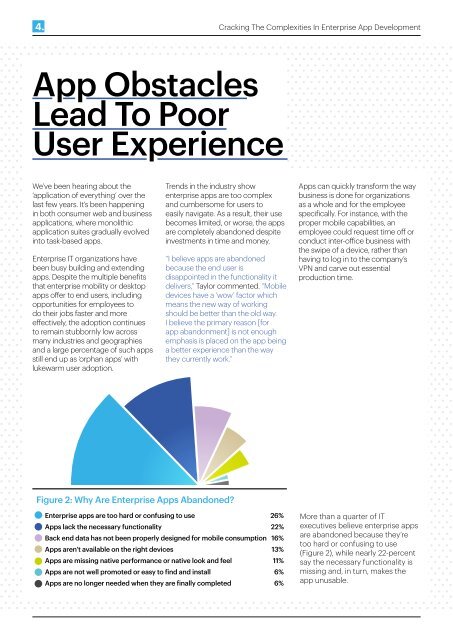Cracking The Complexities In Enterprise App Development
60148KUvs
60148KUvs
Create successful ePaper yourself
Turn your PDF publications into a flip-book with our unique Google optimized e-Paper software.
4.<br />
<strong>Cracking</strong> <strong>The</strong> <strong>Complexities</strong> <strong>In</strong> <strong>Enterprise</strong> <strong>App</strong> <strong>Development</strong><br />
<strong>App</strong> Obstacles<br />
Lead To Poor<br />
User Experience<br />
We’ve been hearing about the<br />
‘application of everything’ over the<br />
last few years. It’s been happening<br />
in both consumer web and business<br />
applications, where monolithic<br />
application suites gradually evolved<br />
into task-based apps.<br />
<strong>Enterprise</strong> IT organizations have<br />
been busy building and extending<br />
apps. Despite the multiple benefits<br />
that enterprise mobility or desktop<br />
apps offer to end users, including<br />
opportunities for employees to<br />
do their jobs faster and more<br />
effectively, the adoption continues<br />
to remain stubbornly low across<br />
many industries and geographies<br />
and a large percentage of such apps<br />
still end up as ‘orphan apps’ with<br />
lukewarm user adoption.<br />
Trends in the industry show<br />
enterprise apps are too complex<br />
and cumbersome for users to<br />
easily navigate. As a result, their use<br />
becomes limited, or worse, the apps<br />
are completely abandoned despite<br />
investments in time and money.<br />
“I believe apps are abandoned<br />
because the end user is<br />
disappointed in the functionality it<br />
delivers,” Taylor commented. “Mobile<br />
devices have a ‘wow’ factor which<br />
means the new way of working<br />
should be better than the old way.<br />
I believe the primary reason [for<br />
app abandonment] is not enough<br />
emphasis is placed on the app being<br />
a better experience than the way<br />
they currently work.”<br />
<strong>App</strong>s can quickly transform the way<br />
business is done for organizations<br />
as a whole and for the employee<br />
specifically. For instance, with the<br />
proper mobile capabilities, an<br />
employee could request time off or<br />
conduct inter-office business with<br />
the swipe of a device, rather than<br />
having to log in to the company’s<br />
VPN and carve out essential<br />
production time.<br />
Figure 2: Why Are <strong>Enterprise</strong> <strong>App</strong>s Abandoned?<br />
<strong>Enterprise</strong> apps are too hard or confusing to use 26%<br />
<strong>App</strong>s lack the necessary functionality 22%<br />
Back end data has not been properly designed for mobile consumption 16%<br />
<strong>App</strong>s aren’t available on the right devices 13%<br />
<strong>App</strong>s are missing native performance or native look and feel 11%<br />
<strong>App</strong>s are not well promoted or easy to find and install 6%<br />
<strong>App</strong>s are no longer needed when they are finally completed 6%<br />
More than a quarter of IT<br />
executives believe enterprise apps<br />
are abandoned because they’re<br />
too hard or confusing to use<br />
(Figure 2), while nearly 22-percent<br />
say the necessary functionality is<br />
missing and, in turn, makes the<br />
app unusable.


